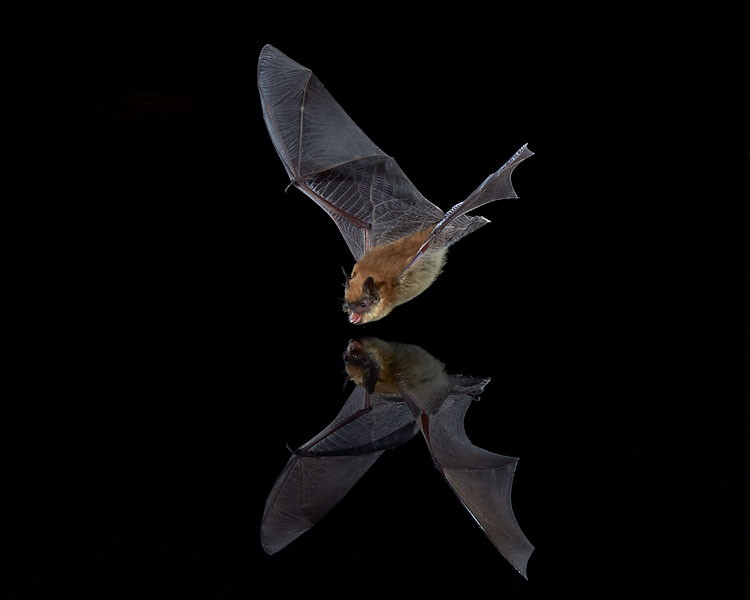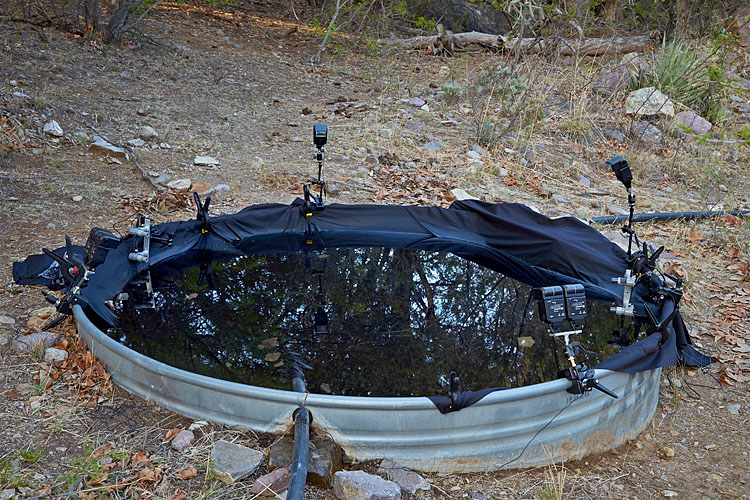Home > Blog > April 23, 2014 – Southwestern Myotis about to drink, Coronado National Forest, Arizona, and the Cognysis StopShot
April 23, 2014
Southwestern Myotis about to drink, Coronado National Forest, Arizona, and the Cognysis StopShot

Southwestern Myotis About To Drink
Coronado National Forest, Arizona, USA
Canon EOS 1D X, 70-200 f2.8 IS II (at 200mm), StopShot, multiple flash, 10 sec, f16, ISO 200
Image taken on April 22, 2014.
After the rain stopped on that second afternoon, Jan came out with me to look at the situation. The stream was a little higher from all of the rain, but water still wasn't reaching the tank. Based on her observations, I built-up the dam to force more water into the new pipe, but still no water flowed into the tank. Then Jan suggested that maybe the pipe was like a syphon. I quickly dismissed that idea because after walking up and down the length of the pipe many times, I was quite certain that the whole length of pipe was a downhill run and wasn't like a siphon. Plus, I wasn't going to suck on the far end of the pipe knowing what was going into the pipe. Because of the possibility that the last section of original pipe, the one that emptied into the tank, was damaged or clogged, Jan helped me replace it with the final piece of new pipe and a different section of old pipe. Now we had a completely new run of pipe from the dam to the tank and still no water reached the tank. Most of the joints were leaking, so water was getting part of the way to the tank. Jan went back to the RV and I kept thinking about the situation. The last joint was leaking by this time, so water was getting almost all of the way to the tank. Maybe Jan was on to something with the siphon idea, so I took the pipe out of the tank and draped the end down in the stream bed to see if that would help. Sure enough, after a while, water started flowing out of the end of the pipe, and boy did my morale improve! It took two tries to get the pipe back up and into the tank with the water still flowing, and I was ecstatic that the tank was finally getting filled. I was also a bit embarrassed that I, with a Ph.D. in computational fluid dynamics, hadn't solved the simple plumbing problem by myself. Based on the flow rate, I expected it to take a few days to fill the tank, so I was very surprised, and thrilled, when the tank was full the next morning!
We set up to photograph the bats that evening, but the process took a little longer than I thought and we didn't capture any bats. However, something did trip the flashes while we were doing the final camera setup which was a good sign. The second night, I captured 1.5 bats. I cut off the wing tip of one bat and only got the wing of another. Last night, I finally got some good images: three bats completely in the frame. This is my favorite image by far because the bat's just about to take a drink so there aren't any distracting water drops flying around. It's a nice pure reflection shot.

The Bat Setup, Overview

The Bat Setup, Closer View Of One Side
The cameras were set to make 10 or 15 second exposures and set to fire repeatedly using a cable release with the button locked down. The actual image is made by the very short flash burst which illuminates the bat and stops the motion. After two or three hours of automatic and unattended operation, we returned and took down the cameras and StopShot setup. Then we looked, with great anticipation, through the mostly all-black images for the ones with a bat.
Categories:
This particular blog entry is www.jameshagerphoto.com/blog/?date=2014-04-23. Visit www.jameshagerphoto.com/blog to view the latest blog entry, and you may click here to create a URL that you can bookmark to go to the latest blog entry.




